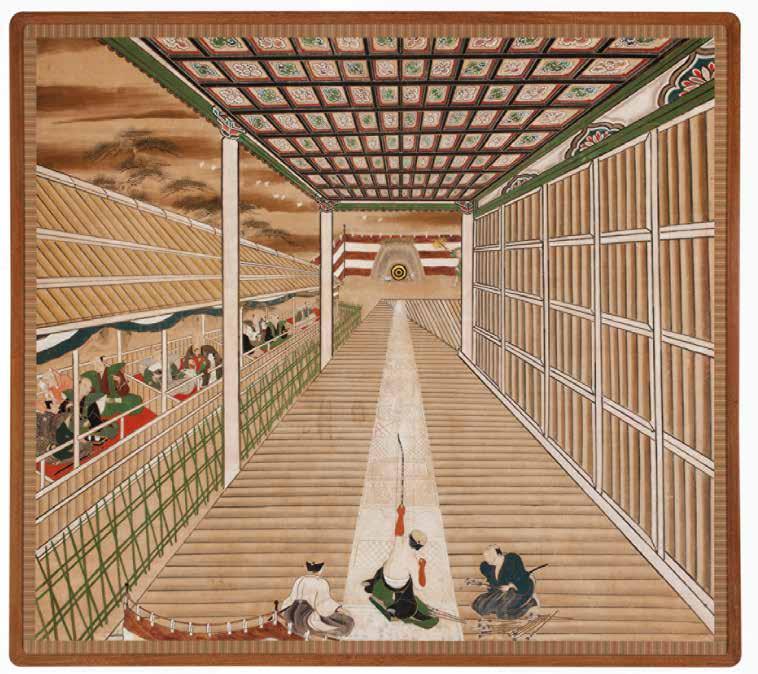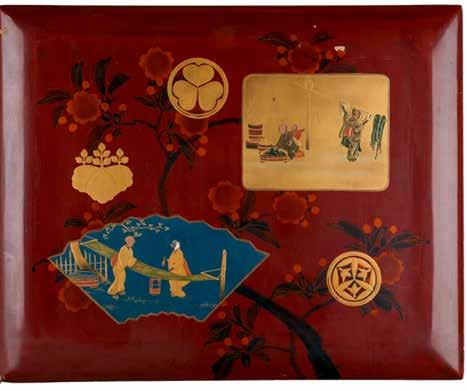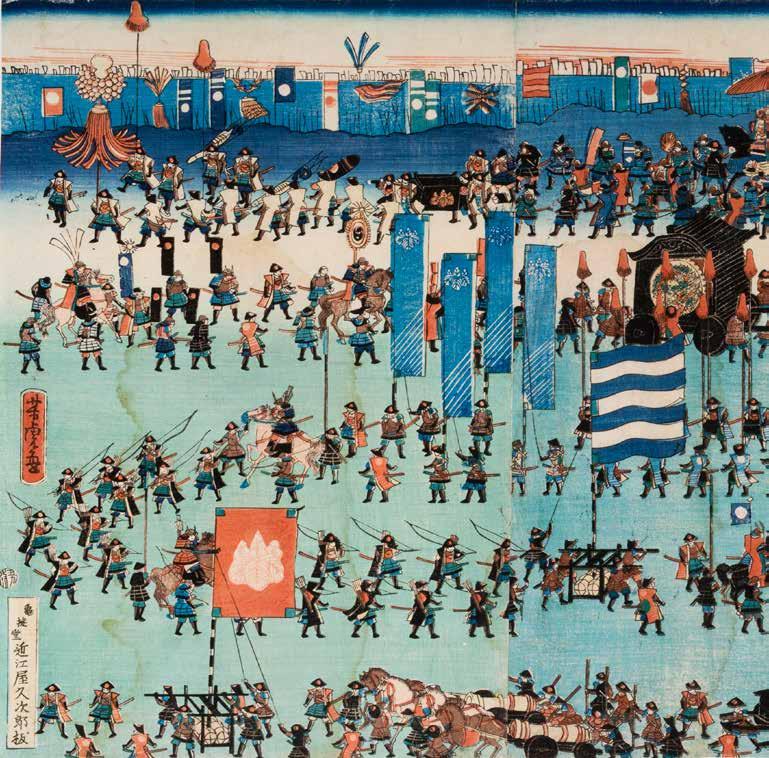
12 minute read
The samurai class: cultivating the arts of war and peace
Russell Kelty
During the last thirty years customs have changed: now when young samurai get together, if there is not just talk about money matters, loss and gain, secrets, clothing styles or matters of sex, there is no reason to gather at all … What things a person should be able to accomplish if he had no haughtiness concerning his place in society. 1
Advertisement
Yamamoto Tsunetomo (1659–1721), retainer, Nabeshima clan
fig. 1: Yoshitora Utagawa, Japan, active 1840–80, Procession of warriors (Musha gyôretsu no zu) 1865, Edo (Tokyo), colour woodblock print (nishiki-e); ink and colour on paper, triptych, 35.8 x 72.5 cm (overall); David Murray Bequest Fund 1940
Sato Hiroaki, Legends of the samurai, The Overlook Press, Woodstock, 1995, p. 287. Yamamoto Tsunetomo, The Hagakure: a code to the way of the samurai, Hokuseido Press, Tokyo, 1980. It is the height of folly to neglect to rule the country by the means of the arts of peace, and to imagine that good government can be achieved by striking out one’s elbows and assuming a fearful countenance, terrifying the people with the threat of punishment and attempting to belabor the country into obedience. 2
Ogyu Sorai (1666–1728), Confucian philosopher
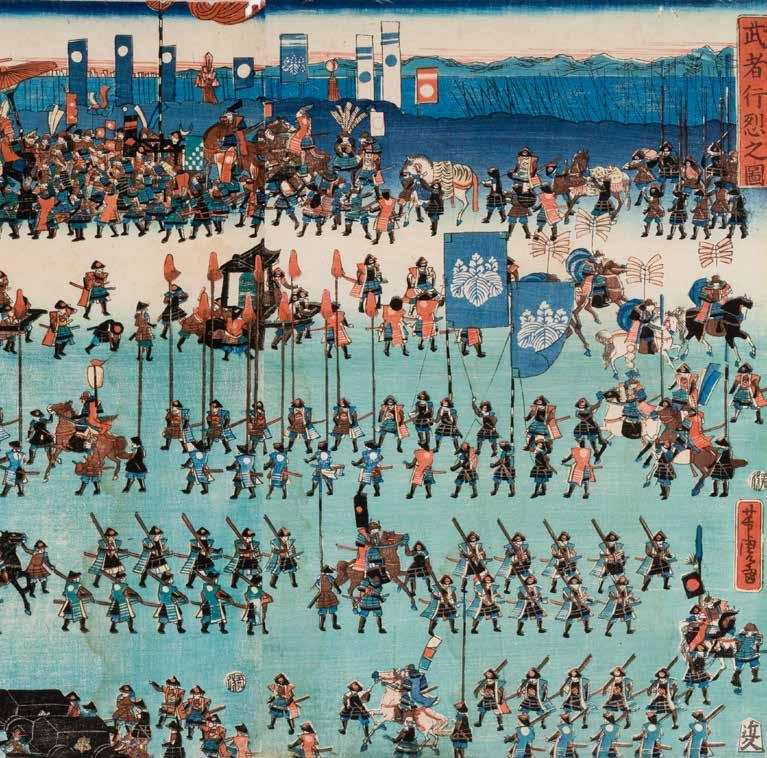

fig. 2, detail: Myōchin Munesuke, Japan, 1643–1735, Samurai armour (gusoku) with breastplate depicting Fudō myōō and inscribed ‘A fortuitous day, the 8th month of the 12th year of Genroku (1699), Myōchin Munesuke’, c.1699, Edo, iron, gilded, silvered and patinated copper, gold leaf, wood, silk, cotton, leather, animal fur, 170.0 cm (height); Gift of M.J.M. Carter AO, Susan Cocks, John Crosby, Dr Peter Dobson, Sandra Dobson, Frances Gerard, Arata Gwinnett, Sam Hill Smith, Shane Le Plastrier, Mark Livesey QC, Joan Lyons, Dr Leo Mahar, Skye McGregor, Diana McLaurin, John Thornton, Zena Winser and David C. Urry through the Art Gallery of South Australia Foundation Collectors Club 2016 fig. 3, right: Japan, Fudō Myōō, 14th–15th century, Japan, wood, traces of colour and gilding, brass, cotton, 60.0 cm (height, including base); M.J.M. Carter AO Collection through the Art Gallery of South Australia Foundation 2017
3 Morgan Pitelka, Spectacular accumulation: material culture, Tokugawa Ieyasu, and samurai sociability, University of Hawai’i Press, Honolulu, 2016, p. 5. Fabian Drixler & William D. Fleming, Samurai and the culture of Japan’s Great Peace, Yale Peabody Museum, 2015, p. 35. In 1615, Tokugawa Ieyasu (1543–1616) destroyed Osaka Castle and assumed control of the archipelago, officially ending the age of war and initiating ‘the great peace’. In the aftermath, Ieyasu organised search parties to comb the wreckage of the castle and collect the broken pieces of ceramics, lacquer, Nō masks and swords once owned by prestigious warriors, tea masters and merchants, which had been amassed by his main rival, Toyotomi Hideyoshi (1537–1598). The remnants of this ‘spectacular accumulation’ were painstakingly repaired and entered Tokugawa’s own collection, extending a ‘symbolic authority over Hideyoshi and heightening his own prestige as a collector of the most cherished objects in Japan’. 3 This culture of appreciation was first established by Ashikaga Yoshimasa (1435–1490), whose failure as a shogun contrasted with his pursuit of beauty and the ideals informing Nō and the tea ceremony, reflecting the influence of Zen practice.
The Edo period is marked by the unification of over 260 regional daimyo, which were established and maintained by the military government of the Tokugawa shogunate. This fragile peace fostered the blossoming of art and culture and gave rise to a lively urban culture of increasingly literate, wealthy and sophisticated townspeople and merchants, who indulged their passion for material culture and the numerous diversions of the floating worlds. In an era of peace and relative prosperity after a prolonged period of war, the shogun, daimyo and samurai were expected to honour their illustrious past and maintain their aesthetic cultivation and
military pursuits in accordance with Confucian values. As such, they projected their cultivation, power, prestige and illustrious past. Although the shogunate employed a rigorous caste system and enacted a series of sumptuary laws in the streets of urban centres like Edo, Kyoto and Osaka, what you read, wore and owned defined your status, and the ruling elite were the most conscious of this fact.
During the great peace, the implements of war so readily associated with the daimyo and samurai were rarely required for daily life. The emphasis on cultural skills grew from the samurai’s need to govern lands acquired through warfare, which were maintained through the arts of the brush not the sword. Administration and participation in courtly arts such as Japanese verse (waka) strengthened the samurai’s cultural authority and prestige. In this age of peace, the warrior class was constantly on display and the armour they wore was no longer an implement of war but instead a symbol of the samurai’s refinement, style and erudition. Armour, in particular, which was costly, was worn during the auspicious times of the year as symbols of wealth and status. Daimyo collections of treasures were divided into two categories: official and private objects (omote-dogu and oku-doge), with armour and swords in the first category. 4 Armour created after the unification of Japan was utilised to evoke the aesthetics of extravagance and restraint so prized by the military elite and was installed in alcoves during auspicious times of the year.
Samurai armour, with breastplate depicting Fudō-myōō is a spectacular example of armour created by master craftsmen in Edo (Tokyo) for the military elite during the Edo period (1615–1868). The pristine condition of this armour is indicative of its careful handling by its owners and also that it was worn for auspicious ceremonies or processions. The Genroku era (1688–1704), when this armour was created, is often regarded as the ‘golden age’ in Japanese history, with a hundred years of peace having fostered an unprecedented flourishing of the arts, as displayed by this suit. The ingenious integration of lacquered iron, chainmail, silk lining and cords provided lightweight and flexible protection, while the stenciled doeskin, gilded copper, wood, animal hair and embossed iron breast plate are all beautifully crafted to portray the aesthetic cultivation of the first owner. The suit embodies the samurai’s life pursuits: to cultivate martial prowess and an aesthetic sensibility (fig. 2).
The spectacular and rare embossed breastplate of the suit was created in 1699 by Myōchin Munesuke (1643−1735?), the fifty-fourth head of a distinguished line of metal craftsmen and premier armour and sword expert of Japan, who lived in Edo. It depicts the wrathful Buddhist deity, Fudō Myōō, the deity most often associated with samurai. Fudō is depicted in his usual form with a sword and lasso and wearing a distinctive Indian dhoti with a striking shippō
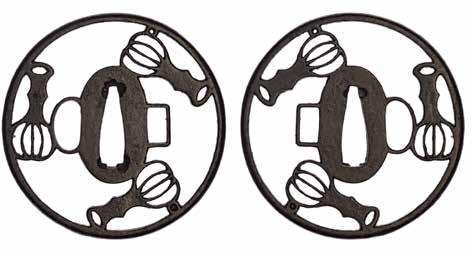
motif, possibly influenced by imported textiles from India or Indonesia (fig. 3). The seventeenth-century breast plate offers a striking contrast to the Gallery’s sculpture of Fudō Myōō (figs 2, 3). The helmet includes a frightful sculpture of a demon or shigami, which was intended to strike fear in the opposition and endow the wearer with talismanic protection. The helmet also carries small crests, which have yet to be identified, but which are no doubt symbolic of the samurai’s status or even his clan affiliations. The box containing the shigami also included a letter dated to the Shōwa period (1926–89), which described the sale of the ‘exquisite armour’ to a private collector.
This type of armour is known as gusoku, which literally means ‘equipment is sufficient’ and refers to a lighter and more flexible armour, suited to the new military tactics that addressed the chaos of the sixteenth century. ‘As military tactics changed to using massed infantry and the introduction of firearms, warriors favoured lighter and more functional suits of armour’. 5 To enable samurai to be recognised in the midst of battle, their armour featured unique and striking ornaments.
One of the most readily identified accoutrements of the samurai was of course their two swords, known collectively as daishō (figs 4, 5, 6). The term refers to the ‘big’ katana and ‘little’ wakizashi or tantō, which became a symbol of the samurai class after the ‘sword hunt’ of 1588 and to be worn only when on official duty. 6 During the peace of the Edo period, samurai cherished the aesthetic value of the swords and as a result decorated them with refined fittings created from iron and featuring gold and elaborate carving. The most aesthetically pleasing swords also display a delicate undulating woodgrain-like pattern on the ground of the blade, the result of the arduous process of its creation.
Through various political devices, the Tokugawa shogunate ensured peace and stability: one of the defining decrees of the Edo period, emblematic of the shogunate’s strategic internal and external strategies to maintain hegemony, was ‘alternate attendance’ (sankin-kotai) (fig. 1). This decree, issued in 1635 and expanded in 1642, has precedents in the Kamakura period (1185–1333), as well as in France under the reign of King Louis XIV, who required ‘nobility of the sword’ (noblesse d’épée) to spend six months of the year at the palace. 7 Alternate attendance required daimyo
fig. 4: Yasuyuki, Japan, active early 18th century, Tsuba, tea-whisks design, early 18th century, Japan, iron, 7.7 x 7.7 cm; Gift of John and Geraldine Halls 1984
5
6
7 Bettina Zorn, The elegance of the Hosokawa: tradition of a samurai family, Hirmer Publishers, Zurich, 2019, p. 34. Victor Harris, Cutting edge: Japanese swords in the British Museum, Tuttle Publishing, London, 2005, p. 26. Constantine Nomikos Vaporis, Tour of duty: Samurai, military service in Edo, and the culture of early modern Japan, University of Hawai’i Press, 2008, p. 2.
fig. 5, above: Japan, Long sword (Katana), c.1780, iron, lacquered wood, shakudō, gold, 92.0 cm (length); Gift of Mrs J. Howard Johnson 1951
fig. 6, below: Japan, Short sword (wakizashi), c.1780, iron, lacquered wood, shakudō, gold, 63.0 cm; Gift of Mrs J. Howard Johnson 1951

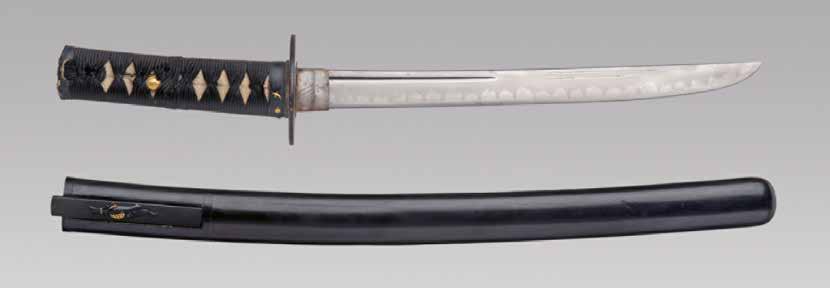
to maintain two residences, one in their domain and the other at the capital. Every other year they were required to reside at Edo while their families remained there indefinitely as virtual hostages of the shogunate. The expense of maintaining two residences, replete with articles of refinement and culture, was compounded by the need to employ vast processional retinues commensurate with a daimyo’s standing and the size of his domain, with these retinues also participating in huge parades. The military parades (daimyō gyōretsu) included hundreds, if not thousands, of lancers, musketeers and archers, who were expected to wear clothing and accoutrements befitting the stature of their daimyo. The size and grandeur of the parades fostered a more comprehensive road system and the dissemination of culture throughout Tokugawa Japan.
Illustrated in prints and handscrolls of the Edo period, chests such as Portable storage chest (hasamibako) (p. 38), covered in lacquer and embellished with family crests in gold, were carried on a pole by lavishly dressed attendants. The most evocative and readily identifiable of these emblems was of course the Tokugawa shogunate crest (mon), composed of three hollyhock leaves in a circle. The Gallery’s large eighteenth-century box is coated with black lacquer, on which the Tokugawa family crests and an arabesque pattern were decoratively applied, using gold and silver
maki-e. The lower portion of the hasamibako has two metal fittings, through which a long wooden pole could be slotted for carrying over the shoulder. The interior of the hasamibako however reveals an unexpected level of elegance, as the entire interior is covered with embossed gold leaf. This may have been a later addition, or the box may never have been used for transport. Hasamibako is emblematic of the high level of craftsmanship and artistry attained in Japan during the Edo period and the vast networks of distribution. In the capital, the belongings and furnishings of the shogunate and wealthy daimyo were of the highest quality and artistry and were divided into two principal categories for public and private display. The Gallery’s hasamibako displays the restraint and refinement that characterises lacquer created for members of the shogunate and was most likely created in the official studios of the Tokugawa family during the eighteenth century for a woman’s trousseau. The pristine quality of the gold decoration (hiramaki-e), black lacquer and the delicacy of the engraved metal fittings have led scholars to believe that Portable storage chest was used to transport clothing and other goods on auspicious occasions. Hiramaki-e, literally means ‘flat sprinkled picture’ and refers to the application of gold powder to wet lacquer, which produces a design in low relief, such as the plant motifs (hanakusa) depicted on the chest. Although this technique was pioneered during the Heian period (794–1185), the relative peace and tranquillity of the Edo period enabled artists to realise its fullest expression.
For the military elite of the Edo period, maintaining their martial prowess and their connection with the illustrious past was required by a series of fifteen laws promulgated by the shogunate, which governed the responsibilities and activities of the daimyo and samurai and ensured perpetuation of Tokugawa suzerainty. Known as the ‘Laws governing warrior houses’ (Buke shohatto) and issued in 1615, they forbade new castle construction and renovation, as well as exhorted daimyo to excel in both the martial and literary arts.
The arts of peace and war, including archery and horsemanship, should be pursued single-mindedly. From old, the rule had been to practise the ‘arts of peace on the left hand and the arts of war on the right’; both must be mastered. 8 (fig.7)
As a result, archery contests and hunting expeditions remained a part of the lifestyle of the military elite. Confucian scholars and advisors to regional daimyo began to write down their own personal codes for samurai to live by, which were often closely guarded and not made public until the late nineteenth and early twentieth centuries.
Birds of prey, used during hunting expeditions, were a symbol of martial prowess. The custom of ‘hawking’ has a long tradition, dating back to the Kamakura period (1185–1333), and maintaining hawks constituted a status symbol. No shogun indulged his passion for hunting excursions into the provinces more than the shogun Tokugawa Ieyasu, as it conjured the fraternity and hierarchy of his warrior past. In the words of one contemporary observer, Ieyasu was a first-rate falcon fetishist (ichi dan taka suki).
fig. 7: Japan, Archery contest at Sanjusangendo (Sanjusangendo toshiya no zu), c.1750, Kyoto, tsuitate screen, wood, silk, ink and pigments and paper, 131.3 x 148.0 cm (image), 143.0 x 159.8 cm (overall); Gift of Frances Gerard and Mark Livesey QC with the assistance of the Roy and Marjory Edwards Bequest Fund through the Art Gallery of South Australia Foundation Collectors Club 2014
8 ‘Buke Shohatto’, in Martin Collcutt, ‘Daimyo and daimyo culture’, in Yoshiaki Shimizu (ed.), Japan: the shaping of Daimyo culture, 1185–1868, George Brazziler, New York, 1988, p. 37.
